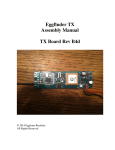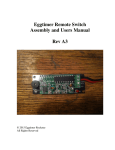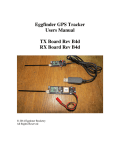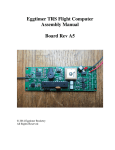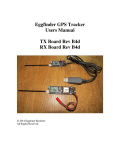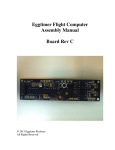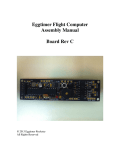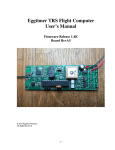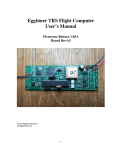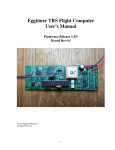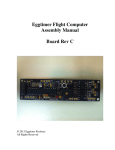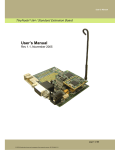Download Eggfinder RX Assembly Manual RX Board Rev B4d
Transcript
Eggfinder RX Assembly Manual RX Board Rev B4d © 2014 Eggtimer Rocketry All Rights Reserved California Proposition 65 Warning WARNING: This product contains chemicals (lead) known to the State of California to cause cancer and birth defects or reproductive harm. This kit includes a special low-temperature ultra-fine leaded solder wire. Including the solder with the kit ensures that you will have solder that can be used to mount the surface-mount parts in the kit. Leaded solders have been used for over a century in electronic assembly, but you should take the following precautions when using it (or just about any chemical, for that matter): • Do not eat or drink while using it • Wash your hands after handling it • Keep it in the protective bag when you’re not using it The MSDS can be found at http://www.kester.com/download/245%20FluxCored%20Wire%20Lead%20Allo y%20SDS.pdf The European Union RoHS (Restriction on Hazardous Substances) regulations exempt kits such as the Eggfinder from its regulations, because they are not for resale and since it is well known that hand soldering with non-leaded solder is much more difficult and more damaging to heat-sensitive components. Important Regulatory Information This device complies with Part 15 of the FCC Rules. Operation is subject to the following two conditions: (1) this device may not cause harmful interference, and (2) this device must accept any interference received, including interference that may cause undesired operation. It is intended to be used ONLY for educational and experimental use in Class II/III amateur High Power Rockets which are classified as aircraft by the Federal Aircraft Administration (CFR 14 §101.25), and which must by FAA and NFPA regulations be operated at least 1,500’ away from any populated buildings. Although unlikely, this device may cause interference with consumer devices that run on the unlicensed 902-928 MHz band, and therefore must not be used in residential areas. The Eggfinder uses RF modules in the 902-928 MHz ISM band manufactured by Hope RF, model HM-TRP-915. They are intended to be used only in the United States. These modules have been tested by Hope RF to be compliant with the FCC Part 15 regulations for nonlicensed intentional emitters, and as such have been permitted to be imported into the US. However, Hope RF (at the time of this document) has not obtained formal certification with the FCC. As a hobby kit, designed for educational and experimental purposes, the Eggfinder is considered by the FCC to be “generally exempt” from authorization requirements. Nonethless, we have made a good faith attempt to comply with all technical regulations, and you should too by building it exactly as per the instructions, and by using only the antenna on the transmitter module that we recommend in the instructions, or a suitable replacement as outlined in the Appendix. Because the Eggfinder runs on an unlicensed band, there is no protection against interference from other sources; basically, you get what you get. We’ve done substantial testing and are confident that your Eggfinder system is unlikely to be significantly affected by outside radio sources, but there’s no guarantee. If your Eggfinder causes interference in a residential setting, or with licensed radio systems (such as TV or ham radio), you must stop using it until you correct the problem. This is extremely unlikely given the small amount of power and the “tightness” of the transmitter’s output, and in particular the distance from any population that HPR rockets must be flown. Nevertheless, you need to be aware of this, and be willing to abide by the rules. These are the same rules that govern other non-licensed transmitters, such as cordless phones, WiFi and Bluetooth® devices, and garage door openers. Important Links: FCC Part 15 (governing unlicensed intentional emitters) http://www.ecfr.gov/cgi-bin/textidx?SID=adb12f74b498e43ec453f7899d9df0fd&node=47:1.0.1.1.16&rgn=div5 Hope RF HM-TRP Documentation (FCC test documentation) http://www.hoperf.com/upload/rf/HM-TRP-915(20dBm)-FCC.pdf FAA Regulations for Amateur Rocketry (Part 101) http://www.ecfr.gov/cgi-bin/textidx?c=ecfr&rgn=div5&view=text&node=14:2.0.1.3.15&idno=14 ~~~~~~~~~~~~~~~~~~~~~~~~~~~~~~~~~~~~~~~~~~~~~~~~~~~~ Before You Start… • If you bought a Starter Set (both Eggfinder TX and RX kits), make sure that both of them are on the same frequency (it’s marked on the package label). If they are not, do not open the kits; contact us immediately so we can send you a replacement kit and a no-charge return label. • Go to our web site at www.Eggtimerrocketry.com and download the latest Release Notes. • Go to our web site at www.Eggtimerrocketry.com and download the latest Assembly/Users Guide.. • Read them thoroughly before starting… it will save you some grief later, we promise! ~~~~~~~~~~~~~~~~~~~~~~~~~~~~~~~~~~~~~~~~~~~~~~~~~~~~~~~~~~~~~~~~~~~~~~ Thanks for buying an Eggfinder GPS Tracker! The Eggfinder is a hobby rocketry GPS tracker that uses a GPS module and a 900 MHz license-free transmitter module to broadcast your rocket’s location in real-time to a computer or tablet. With appropriate GPS tracking software, which is available for free on the Internet, you can actually track your rocket in flight, and ultimately find out exactly where it landed. Like other Eggtimer Rocketry products, we sell it as a kit, to keep costs down and provide an outstanding value. This means that you have to do a little work, of course, but considering that most hobby rocketeers that would use our products have some degree of electronics expertise, this should not be much of an impediment. If you do not have any experience soldering kits such as the Eggfinder, we recommend that you ask around… chances are that somebody in your rocketry club would be more than happy to assist you for a small bribe (beverages work well!). There are actually two separate Eggfinder boards, the Eggfinder TX that goes into your rocket, and the Eggfinder RX board that receives the data from your Eggfinder TX board and displays it on your computer or tablet. They are similar in that they both have a radio module and power supply, but only the TX board has a GPS module. We recommend that you build the TX board first, because it’s easier to tell if it’s working, and when you have the RX board completed it will be easy to tell if that one is working too since both boards have LEDs that tell you if they are transmitting/receiving data. About Soldering Your Eggfinder… Assembling your Eggfinder isn’t that hard, but we recommend that you don’t choose it as your first kit project. You must be able to solder small components using fine solder and get nice shiny solder joints. If you have never soldered before, you need to learn anyway, because if you are going to do rocketry electronics you’re going to be doing some soldering. If you want to get into advanced projects like telemetry, you’re probably going to be doing a lot of soldering. We recommend that you get a few small kits from Ramsey or SparkFun, put them together, and hone your skills on them first. There’s a lot of fun stuff out there, so go for it! The Eggfinder uses a few Surface Mount Technology (SMT) parts, they are large by SMT standards, and are within the realm of being hand-solderable. In our case, there are two “modules”, the GPS module and the RF module, that could potentially be damaged by the heat of surface-mounting them in an oven; that’s why we chose to have you solder them. In order to help make your assembly successful, we have included about 12” of very fine (.020”), very low temperature (about 180°C), no-residue solder. This is not the stuff that you get at Radio Shack… it’s designed for soldering small temperature-sensitive parts without transferring much heat to the part itself. Important Note: DO NOT use any kind of extra flux with this board. There is no reason for it because the parts are new and clean, and any flux that you buy is almost certainly going to be incompatible with the flux in the no-clean solder. Extra flux just makes a mess, and may require excessive heat in order to boil off the flux, possibly damaging the sensitive components in the kit. For soldering components on a board like the Eggfinder, we recommend a small pencil soldering iron, about 15W. If you are only going to use it occasionally, Weller makes a decent cheap 12W iron, it’s about $15. There is also a similar iron that’s sold by ECG. We like those, but the copper tips seem to oxidize and corrode rather quickly compared to some more expensive irons; fortunately, the tips are replaceable and cheap. Better would be a fancier soldering pencil with iron tips; those run about $30, but they’ll last forever. The best iron would be a temperature-controlled solder station, they typically start at about $50 for a cheap one and can go to a few hundred dollars if you want to get really fancy. Weller makes a good one for about $50, if you make the investment that will probably be the last soldering iron you will ever need to buy. These solder stations usually have a little well with a tip-cleaning sponge, so they end up taking less room on your workstation too. Get the smallest tip you can find, preferably with a conical tip that’s about the same width as the smallest pad. General Assembly Information We’re sure that you are ready get started, but before you do you will need to get some tools together. The tools that you will need are: ___ Low-wattage soldering iron, 15W or less, with a fine conical needle tip ___ Small needle-nose pliers ___ Small diagonal cutters ___ Tweezers to handle the SMT parts ___ A small damp sponge for cleaning the tip of your soldering iron ___ A lighted magnifier, for inspecting solder joints (not essential, but very helpful) ___ A jewler’s loupe or small 10x magnifier, for inspecting the SMT solder joints (again, not essential but VERY helpful) ___ A well-lighted place to work, preferably with a wood or metal surface, also preferably not carpeted ___ Some PAPER masking tape (do NOT use Scotch® tape or electrical tape) ___ A round wooden toothpick Each installation step has a check-off line, we strongly recommend that you check them off as you go, and that you perform the steps in sequence. We have listed the steps in order to make it easiest to assemble the Eggfinder, deviating from them isn’t going to make your life any easier. We strongly recommend that you consult the assembly pictures on the Eggtimer Rocketry web site, at : http://www.eggtimerrocketry.com/page16.php?view=thumbnailList&category=8&image=92 Each step is pictured, so you can see exactly what you need to be soldering. Looking at the pictures as you go will help prevent you from soldering the wrong thing, or putting something in the wrong way. Assembling your Eggfinder RX Board Step 1: Sort the Components Before you start soldering anything, you need to lay everything out and make sure that you are familiar with all of components, and that you have everything. If you are missing something, let us know immediately so we can send you whatever you need. You should have the following parts, check them off as you sort them… __ Qty 1 Description Circuit board __ 1 Hope RF HM-TRP-900 RF module __ 1 LM1117-33MPX 3.3V voltage regulator __ 1 3mm Red LED __ 1 2.2K ohm 1/8 watt resistor (bands are red-red-red) __ 1 10 uF electrolytic capacitor (tubular component with two wires, one is marked “- - - - -“ on the side of the case) __ 1 47 uF electrolytic capacitor (tubular component with two wires, one is marked “- - - - -“ on the side of the case) __ 1 USB-Serial Cable __ 1 1/32” Brass Antenna wire (4”) __ 1 3 ½” length of 1/16” heat-shrink tubing __ 2 Small zip ties __ 1 Coil of .020” 63/37 No-Clean solder wire Note that some of the components are static sensitive, so you should avoid sources of static electricity while you are handling them. We recommend that you assemble the Eggfinder on a wood or metal surface unless you are fortunate enough to have a high-temperature anti-static mat (don’t buy one just to build the Eggfinder, however!) Avoid putting it on plastic surfaces that generate static, and preferably put it together in a room that’s not carpeted. That being said, it’s very unlikely that you will zap any of the components in the Eggfinder with static electricity, but consider yourself notified of the possibility… Also note that some of the components are polarized, i.e. it matters which way you put them in. If you solder one of these components in backwards, the effect will range from something not lighting up (LEDs) to nothing at all working. It is CRITICAL that you test-fit the parts before you solder, and that you make SURE that you have them pointed the right direction before soldering. Like the old adage says, “Measure twice, cut once.” If you solder a part onto the board incorrectly, it can be a minor pain to remove if it only has two pins, or it can be virtually impossible for something with a lot of pins. The Eggfinder Limited Warranty does not cover incorrect assembly, so if you mess up badly enough you may end up having to get another kit and starting over; neither of us want that. It is very important that you assemble the Eggfinder in the order listed. This makes it easier to access the surface-mount components, if you start soldering out of order it’s going to be tough for you to get to the pads of the SMT parts. Some of the instructions will call for you to tacktape parts to the board to maintain alignment while you solder. You should ONLY use paper masking tape for that purpose, DO NOT use “Scotch”® tape or electrical tape for this; plastic tapes can pick up static electricity and damage parts, and electrical tape tends to leave a sticky residue. Eggfinder RX Assembly Checklist Before you solder anything, make absolutely sure that you have the correct part and that it is inserted in the board correctly. The board has all of the component values, outlines, and polarities silk-screened on the top, so there shouldn’t be any doubt about what goes where and how. Nevertheless, if you have any questions about the assembly procedure, do not hesitate to drop us a line at [email protected] before you solder the parts to the board. You may have to wait a day for the answer, but it could save you a lot of grief later on! The Eggfinder Limited Warranty does not cover damage to parts while attempting to desolder them because you inserted something incorrectly. We spent a lot of time making sure that the assembly instructions were clear, but once again if you have any questions about the assembly procedures drop us a line at [email protected] before you solder. OK, so let’s get started… __ Mount the the Voltage Regulator Locate the large pad and the three small pads for the voltage regulator. Heat up the pad with your soldering iron and melt a small amount of solder on the large pad, just enough to cover it. Place the voltage regulator IC in place, and hold it down, then heat up the large pad on the voltage regulator until the solder starts to flow. Hold your soldering iron on the pad for another 5 seconds, then remove it and wait at least 10 seconds. One by one, solder the three small three small leads to the pads, using enough solder to cover the pad and get a good “tenting” on the leads without creating solder “blobs”. Wait at least 30 seconds between each pad to prevent the chip from overheating. ___ Mount the RED (PWR) LED Insert the RED LED into the holes for the PWR LED, make sure that the LONG lead is in the hole maked “+”. LEDs are polarized, if you put it in backwards it will not work, so doublecheck! Turn the board over and solder the leads to the board. Trim the leads flush. ___ Mount the 2.2K Resistor (red-red-red bands) Bend one lead back on the 2.2K resistor. Locate its position on the board, and insert the resistor in the board. Turn over the board and solder the resistors in place, trimming the leads flush afterwards. ___ Mount the 10 uF electrolytic capacitor Insert the 10 uF electrolytic capacitor into the holes on the board, making sure that the lead with the “- - - -“ markings next to it is inserted OPPOSITE the hole marked “+”. Double- check to make sure that you have this inserted correctly! Turn over the board and solder the leads to the board. Trim the leads flush. ___ Mount the 47 uF electrolytic capacitor Insert the 47 uF electrolytic capacitor into the holes on the board, making sure that the lead with the “- - - -“ markings next to it is inserted OPPOSITE the hole marked “+”. Doublecheck to make sure that you have this inserted correctly! Turn over the board and solder the leads to the board. Trim the leads flush. Mounting the Hope RF Radio Module You will be surface-mounting the Hope RF radio module to the board, the pads are relatively large and spaced relatively far apart, so if you didn’t have any trouble with the voltage regulator you won’t have any problems with the RF module either. __ With a piece of paper masking tape about 2” long, tape the board to your work surface so it won’t move. Don’t cover the area where the RF module is going to be mounted! __ Cut another piece of masking tape about 2” long and about ½” wide. __ Carefully position the Hope RF module on the board so that its pads line up in the center of the top pads, the “half-moon” cutouts on the module should be centered on the pads on the board. With the masking tape that you just cut, lay it across the top to hold it in place on the board. Make sure that it’s properly positioned, there are some small holes on the pads on the module, they should line up with similar holes on the board. You may find that using a few pieces of cut-off resistor leads helps, put one in each corner to line up the holes before you tape the module down. It is important that the masking tape covers as much of the RF module as possible, up to the exposed pads. This is to prevent any errant solder splatter from getting onto the RF module. There are some VERY tiny exposed parts on the RF module, if you get the tiniest bit of errant solder on the module chances are excellent that it will be ruined __ Solder the TOP RIGHT pad of the Hope RF module to the board. Make sure that the board is properly positioned after you solder this joint; it it moves, heat up the solder joint and move the board slightly so that it is properly positioned. Wait 30 seconds after soldering before continuing. __ Stick a round toothpick in the hole in the middle of the solder pad marked ANT. This is to prevent any solder from getting into the hole. Solder the BOTTOM LEFT pad of the Hope RF module to the board, this is the one next to the ANT terminal. Wait 30 seconds, then remove the toothpick. __ Solder the remaining pads to the board, waiting 30 seconds between pads to prevent the module from overheating. If you used cut-off resistor leads to line up the holes, be sure to remove them before soldering the pads. __ With a permanent marker, write the RF module’s frequency on the board in the space provided next to the antenna (i.e. “915”). Eggfinder RX Antenna Options The Eggfinder has pads for either a permanent “stick” antenna or a RP-SMA edge connector for a removable/remote antenna. Your choice of antenna will depend largely on your rocket, and how much range you need. The standard Eggfinder RX ¼ wave “stick” antenna is very simple and produces decent gain without being directional (i.e., the signal strength is pretty much the same in all directions). We have maintained a line-of-sight range of over 8,000’ with this antenna, we think that most people will find that this simple antenna will suit their needs just fine if your primary goal is to get good enough GPS data to help you easily find your rocket. In some cases, however, you may need to use a different antenna. If you want to track your rocket’s flight as accurately as possible or if you are intending to fly over 10,000’, you may need to use a higher gain antenna, such as a 5 dB dipole antenna. If you’re really going high, you may want to use a high-gain directional antenna, such as a 10 dB panel antenna. In those cases, you will want to go with the RP-SMA connector option. Note that any antenna that you get must have an RP-SMA MALE connector on it; this connector has INSIDE threads with a JACK in the center of the connector. It must also be rated for the 900 MHZ band, NOT 2.4 GHz. Be careful what you buy, we have seen some eBay-type vendors that are selling 2.4 GHz “WiFi” antennas for use with 900 MHz systems. They “will” work, but they are certainly not optimal, and would most likely produce less range than the stick antenna. Also, be sure that it’s a RP-SMA antenna; we’ve seen some vendors selling standard SMA antennas but calling them RP-SMA. If your antenna requires a pigtail cable, get the shortest length that will work, to minimize signal loss due to cable resistance and impedence mismatch. Usually, you can get them in ½ meter (about 19”) lengths, this should be fine for most applications. A pigtail cable rated for 2.4 GHz will work fine at 900 MHz, and a ½ meter length is so short that the type of cable (typically RG-174) is irrelevant. Make sure that the pigtail’s other connector matches your antenna, of course; most of the panel antennas use N-female connectors (outside threads, center jack) so you will most likely need an N-male connector (inside threads, center pin). Directions for installing a RP-SMA connector are at the end of this manual; the following instructions are for the “stick” antenna, and can be skipped if you are going to use a connector. Building the Stick Antenna ___ Using a hard eraser or emery cloth, clean about ½” from one end of the antenna to remove any signs of oxidation. ___ Bend one end of the 1/32” brass antenna wire in a 90° angle, about 1/8” from the cleaned end. ___ Put the bent end of the antenna into the ANT pad, but do not solder it in. Have it stick straight out from the board, and tape it in place. ___ Measure 80 mm from the edge of the board, and mark the antenna wire there. ___ With a pair of sharp diagonal pliers, cut the wire at the 80mm mark. ___ Remove the wire from the board. ___ With some emery cloth or a jeweler’s file, file down any sharp edge at the cut so that it is flat. Feel the edge with your finger, if you feel a sharp edge then keep filing until it’s smooth. The goal is to get rid of any sharp edges, as these will reduce the efficiency of your antenna. ___ Put some masking tape on the two pads on either side of the antenna, to prevent solder from getting on the pads. ___ Insert the bent end of the wire into the ANT hole on the top of the board. Solder it in place on the TOP of the board, making sure that it sticks straight out from the board. Clip any protruding lead on the BOTTOM of the board flush, then solder the bottom pad. The idea is to not have any antenna lead protruding from the bottom of the board. ___ Solder the antenna wire to the pad on the top of the board, up to the edge of the board. ___ Remove the masking tape coving the side pads. ___ Wrap 3 or 4 turns of masking tape around the RF Module. Slide the heat-shrink tubing over the antenna wire, then with a heat gun or small torch on VERY low heat, carefully shrink it over the wire. Wait at least 60 seconds, then remove the masking tape. Eggfinder RX Serial Options The purpose of the Eggfinder RX board is to receive the radio-encoded GPS data stream from your Eggfinder TX board, and to convert the radio signal into a serial data stream that can be fed into your laptop or tablet. The RX board includes a USB-Serial cable that powers the board from a standard (Type A) USB port, and provides a serial port for use with most laptop computers and tablets with a USB port. It works very well with the software setup described in the Eggfinder Users Guide. Alternatively, you can use a 2S 7.4V LiPo battery to power the Eggfinder RX board, and a generic Bluetooth®-Serial board so that you do not have to plug the Eggfinder RX into your laptop/tablet. You can easily mount the Eggfinder RX board, a Bluetooth®-Serial module, and a 750 mAH 2S LiPo battery into a small plastic handheld case, giving you a portable receiver solution for use with a tablet without requiring a cable. We have tried generic “HC-06” Bluetooth® modules with the Eggfinder RX, they work well enough, particularly with Android® tablets that may not have a wired serial port. If you want to try this in lieu of the USB-Serial cable, please consult the Application Notes on the Eggtimer Rocketry web site. We recommend that you use the included USB-Serial cable for initial testing, then once you have confirmed that it’s working you can always go back and remove the cable and put a battery and Bluetooth®-Serial module in its place. Mounting the USB-Serial Cable __ Clip the leads of the USB-Serial cable just behind the little sockets __ Strip 1/8” from the BLACK, RED, and WHITE wires. Tin the bare ends. __ Clip the GREEN wire off close to the cable jacket (it won’t be used) __ Solder the tinned wires into the pads on the board as follows: BLACK - BATTERY “-“ RED – BATTERY “+” (NOT the pad marked “3.3V” next to the RF module!) WHITE – RXD (next to the RF module) __ Using a zip tie through each of the two sets of holes near the voltage regulator, tightly attach the cable to the board. The end of the cable jacket should protrude about 1/8” from the forward zip tie. Trim as necessary. ~~~~~~~~~~~~~~~~~~~~~~~~~~~~~~~~~~~~~~~~~~~~~~~~~~~~~~~~~~~~~~~~~~~~~ Assembly of your Eggfinder RX is now complete. Inspect the solder side of the board carefully, looking for “cold” or incomplete solder joints. Cold solder joints appear dull instead of shiny, and may appear as blobs of solder and not have the nice “wetting” of the pad that you will see with good joints. A magnifying light is good for checking the board. We do NOT recommend using flux remover or other cleaners on this board, they may not be compatible with the no-clean flux used in the included solder. Testing Your Eggfinder RX To test your Eggfinder RX, you will need a working Eggfinder TX module on the same frequency and either a laptop computer with a USB port or a USB power “block” like the ones that come with many cell phones and tablets. For testing power-up, you only need to power up the USB-Serial cable, obviously you will need a computer for displaying and saving the GPS data. Note: If you elected to skip the USB-Serial cable and use a Bluetooth®-Serial module and battery instead, you will need to consult the manual for your module to establish a serial connection. In general, you set your laptop/tablet’s Bluetooth® radio to “discovery” mode, power up the Bluetooth® device, then select the device (typically named “HC-06”) and pair it with your laptop/tablet using its password (typically “1234”). To begin, power up your Eggfinder TX module: Press and hold the button until the GREEN LED comes on and the RED LED on the RF module begins to blink. Plug the USB cable from your Eggfinder RX into a USB port on your laptop/tablet, the RED LED should immediately come on indicating that you have power. After one or two seconds, the GREED LED on the RF module should begin blinking, indicating that it is receiving data from the Eggfinder TX board. If you place the boards close to each other, you will see that the LEDs on the Eggfinder RX and TX boards are in sync with each other. In order to receive serial data on your laptop/tablet, you may need to load the cable’s serial driver onto your laptop. The cable uses a Prolific PL2303HX chip, you can get the driver at: http://prolificusa.com/pl-2303hx-drivers/ Pick the one that’s appropriate for the operating system that you’re using. Note: If you have Windows 8, you may need to use an older “Vista driver” in order for it to work on your PC. Don’t ask us why, it just seems to work. Check the Eggtimer Rocketry web site under Support/Documentation for the older driver version. A good program to test the GPS operation of your Eggfinder is VisualGPS, it’s a free Windows program that logs the NMEA data, shows you the approximate location of where it is on a “grid” system (not on a map, though), and shows you the satellite strength. The nice thing about it is that it will automatically pick up the serial port that’s being used for the GPS data, so you don’t have to figure it out. Alternatively, you can use a simple serial terminal program (such as Hyperterminal or PuTTY) set to the serial port that’s being used by your device. Simply connect to the port, and you should see the serial data feed from the GPS. You need to set the port to 9600 baud, 8 bits, no parity, 1 stop bit, and no handshaking/flow control. Once you’ve confirmed that everything is working, you can turn off the Eggfinder TX by holding the button down until the GREEN LED goes out, the GREEN LED on the Eggfinder RX module should also immediately stop blinking since no more data is being transmitted. Unplug the USB cable, remove power from your Eggfinder TX board, and you’re all done! Troubleshooting If your Eggfinder RX doesn’t work after assembly and testing, take a deep breath, get out a beverage to clear you mind, and start troubleshooting… Check Your Solder Joints The very first thing you should do is to check out all of the solder joints under a lighted magnifier, or with a 10x jeweler’s loupe or magnifier. The most common reason for things not working are solder bridges, i.e. putting too much solder on the pads and shorting two adjacent pads together. You can also get into problems by bridging pads with “vias” on the board, the smaller holes that don’t have any components soldered to them. Most of the holes and the pads are very small, so it doesn’t take much solder to get a nice “tented” solder joint. If you get a solder bridge, heat it up and use a solder wick or a vacuum bulb to remove the excess; afterwards, we recommend resoldering the joints. Note: NEVER use “canned air” or compressed air to “blow away” excess solder. The resulting splatter will almost always cause more damage than the original solder bridge. Another thing to look out for is “cold” solder joints, they look dull and blobby compared to a nice shiny “tented” solder joint. Cold solder joints won’t conduct well; at the low power that the Eggfinder RX uses this could easily keep things from working. If you have a cold solder joint, heat it up and put just a little bit of solder on it, the main idea is to get a little more flux on the joint. If there’s too much solder, use a fine solder wick or (preferably) a vacuum bulb to remove the excess, then heat it up and resolder the joint. Check Your Component Polarity Most of the through-hole components aren’t polarized, with some notable exceptions. The outline of the parts is silk-screened on the board, so you should be able to see readily if you have a component soldered in backwards. Components that are polarized are: • The electrolytic capacitors, the side marked “-------“ should be OPPOSITE the side marked “+” on the board. • The LEDs, the long leads should have been inserted in the pad marked “+”. Unfortunately, once you clip the leads it may be difficult to tell if you have inserted it correctly. If you inserted a component incorrectly, you will have to carefully unsolder it, clear any solder residue from the holes, and resolder it. If you find that a component was soldered incorrectly, you will have to use a vacuum bulb or vacuum desoldering tool to unsolder it. We cannot stress enough that you need to check the orientation of the parts before you solder them. The Eggfinder Limited Warranty does not cover damage to a component while attempting to unsolder it, so make take your time and make sure you get it right before you solder. Check Your Cabling Make sure that the RED wire on the cable is on the “BATT +” pad (NOT the “3.3V” pad next to the RF module!), the BLACK wire is on the “BATT –“ pad, and the WHITE wire is on the “RXD” pad (next to the RF module). If It Still Doesn’t Work… There is, of course, always an outside chance that you have a bad component. We test each PC board and the surface mounted components before they leave us. Nevertheless, it is always possible that something may be wrong; there may be a bridge on the PC board itself, etc. If you have gone through all of the troubleshooting steps and the board still doesn’t work, let us know at [email protected] . A high-resolution picture (5 megapixel or better) of both sides of your circuit board and a description of the problem would be very helpful… Troubleshooting Tips (in approximate order of likelihood) RED PWR LED doesn’t come on • Cable wired incorrectly (RED wire should be on BATTERY + pad, BLACK should be on BATTERY -) • Check the polarity of the LED… it may be in backwards • Bad solder joint on the RED LED or the 2.2K resistor next to it • Incorrect battery polarity, or bad solder joint on battery connector pads • Bad solder joint on voltage regulator • Bad polarity on electrolytic capacitors • Bad solder joint on electrolytic capacitors RED LED on the RF MODULE doesn’t flash • No matching Eggfinder TX board transmitting (are they on the same frequency?) • Bad solder joint on the RF Module • Solder bridge on the RF module pads Can’t Receive Data from the USB Serial Cable • Driver for Prolific PL2303HX chipset not loaded in your device • Serial port not properly configured (should be 9600 baud, 8 bits, 1 stop bit, no parity, no flow control/handshaking) • Application not using the proper serial port (check your device settings for the correct port) • Cable incorrectly wired… WHITE wire should be on RXD pad next to RF module Installing a RP-SMA Connector for an External Antenna If you decide to install a RP-SMA connector for an external antenna on your Eggfinder RX board rather than using the “stick” antenna, you will need to follow the directions below. For each board on which you want to install a connector, you will need: ___ RP-SMA board-edge connector, straight, .062” (1.5mm) board thickness (Linx Wireless part number CONREVSMA003.062 or equivalent) You can get these from Eggtimer Rocketry, and you can also get them from electronics distributors such as DigiKey, Mouser, and Future Electronics. They’re under $5 each in small quantities. If you look at the connector, you will see that there are two sides, separated by the thickness of the PC board. The TOP side has three pins, the BOTTOM side only has two (there is no center pin). Inside the outside-threaded connector is a pin; this is why it’s called a “reverse” connector, normally outside-threaded connectors have a socket in them and the matching connector (with inside-threads) has a pin. ___ Slide the RP-SMA connector on the edge of the board, so the three pins on the top line up with the pads on the top of the PC board. With some masking tape, tape it into place on the bottom of the board so it won’t move, leaving the pins and pads on the top untouched. ___ Solder ONE of the pins on the top side to the pad on the top of the board. (Note: You may find that the solder that comes with the Eggfinder kit is too fine for soldering these large pins to the board; if that is the case, use some “conventional” .032” 60/40 rosin-core solder for the outside pins, but you DO need to use the included solder for the center antenna pin.) Let it cool for at least 30 seconds. ___ Check the connector to make sure that it is straight. If it has gotten a little crooked, heat up the solder joint and gently move the connector into place. ___ Solder the other two pins to the pads on the top of the board. ___ Turn the board over, remove the masking tape, and solder the remaining two pins to the pads on the bottom of the board.

















